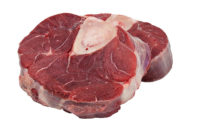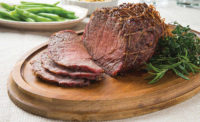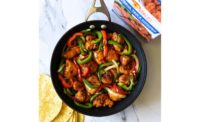In many Asian cultures, goat meat is consumed traditionally with the skin left on during harvest and fabrication. However, the exact reason why is unknown. We hypothesize that the Asian consumers prefer skin-on goat meat because collagen in the skin will gelatinize through moist heat cookery and create a lubrication effect similar to the intramuscular fat, resulting in improved juiciness and tenderness.
In order to test the hypothesis, we harvested 14 goats in two different harvesting techniques: seven with skin left on the carcasses (skin-on) and seven with skin removed (skin-off). In the skin-on harvest group, carcasses were scalded and dehaired at 61oC for 3 minutes to remove most of the hair after stunning and exsanguination. The skin-off harvest group was harvested the same as the traditional lamb harvest, using the fisting technique, which the fist and arm were placed between the fell membrane and skin to assist the pelt removal process. All goat carcasses regardless of harvesting techniques were fabricated into four primals: breast, leg, loin, and shoulder and cut into 2 in. x 2 in. cubes for a total of 8 treatments (2 harvesting techniques x 4 primals). The goat meat was stewed for 90 minutes in water at 93oC.
A panel of 53 Asian consumers were recruited from Manhattan, Kan., to evaluate overall tenderness, juiciness, flavor, the amount of connective tissue and fat, and the overall liking of the stewed goat meat. In addition, biochemical factors such as collagen content, ultimate pH, moisture percentage and lipid percentage were also analyzed for the 56 samples. Finally, biochemical factors were correlated to Asian consumer overall liking to determine the key factors that contributed to Asian consumers’ preference for goat meat.
Asian consumers determined shoulder and breast are more tender and juicier than loin and leg. However, they also determined the breast primal to have too much fat, which resulted in shoulder being the most overall liked cut, followed by loin, breast, then leg. On the other hand, Asian consumers found cuts with skin-on were more tender and juicier but had more fat. Despite of the improvement in the tenderness and juiciness, cuts from skin-on processing were not found to differ in consumer overall liking compared to cuts from skin-off processing.
Biochemical analysis revealed that the meat primal significantly affected ultimate pH, moisture percentage, lipid percentage and collagen content, while processing only affected collagen content. The shoulder primal had the highest ultimate pH followed by breast, leg, then loin. The leg had the highest moisture percentage followed by loin, breast, then shoulder. Lipid percentage followed the exact opposite trend. Breast had the highest collagen content followed by loin, shoulder, then leg. As expected, cuts that were processed with skin-on had more collagen than cuts without skin. Lipid percentage had a positive correlation with overall tenderness, juiciness, flavor, amount of fat, and most importantly, consumer preference.
As expected, ultimate pH also had a positive correlation with overall tenderness and juiciness. To our surprise, collagen content did not exhibit a relationship with any parameters of the consumer panel. In conclusion, neither collagen content nor fabrication process with skin-on or off affected Asian consumer overall liking, but meat cuts with greater lipid percentage and greater ultimate pH were found to be the more important palatability traits to the Asian consumers. The results are encouraging to goat producers and processors who are interested in this ethnic niche of the goat market, as harvesting goats with skin-on could save time in processing and increase yield as well as increasing some of the palatability traits in comparison to the traditional skin-off harvesting. In addition, goat primals such as the shoulder could be sold at a higher price point due to its greater overall liking among Asian consumers. IP




Report Abusive Comment